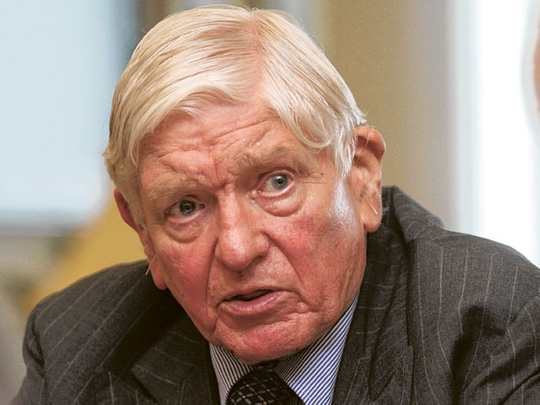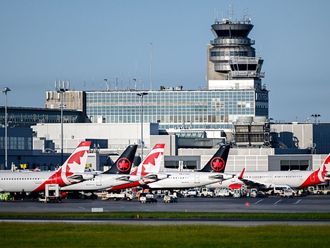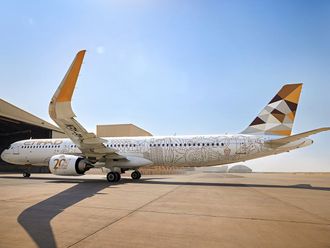
Just on and on, more of the same. Outpacing other airlines." That's the general business plan from here on for Dubai's flagship carrier Emirates, according to its executive vice-chairman Sir Maurice Flanagan.
Awaiting delivery of about 204 aircraft with an average of one Airbus A380 superjumbo and a Boeing 777 every month for the next 12 years, the airline is going full speed to attain its goal of connecting any two destinations in the world with one stop in Dubai.
Open skies
Born out of Dubai's open skies policy that rules out preferential treatment for any airline, even its own carrier, Emirates has seen phenomenal annual growth of over 20 per cent on average in its 25 years of operations.
From the start of the city's aviation industry, the late Shaikh Rashid Bin Saeed Al Maktoum demanded that its air space must welcome all in order to propel its economy and, specifically, its trade. No other place in the world except Singapore has opened its skies so completely to commercial carriers.
"There is a great synergy between growth of Dubai and the growth of the airline. Although that was never given to us as a target, part of our function is to help Dubai grow - this air transport dependant community. I think we have succeeded indeed," Sir Maurice said of the airline that has has constantly connected Dubai to new destinations.
The mammoth A380 is at the centre of Emirates expansion strategy.
The initial order for 22 A380s gave Emirates the launch customer status that has fuelled later purchases of the same model.
"I don't know what the others guys are waiting for. That aircraft is absolutely superb," Flanagan said about the A380.
The order for the first 22 with an asking price of $250 million each (Dh918 million), had to be approved by His Highness Shaikh Mohammad Bin Rashid Al Maktoum, Vice-President and Prime Minister of the UAE and Ruler of Dubai, as are all large orders by the airline.
That decision was made within a week, Flanagan says. "Being so quick off the mark, we got first launch customer status. That means we got a discount on the price of the aircraft and that has grandfathered through to all the other subsequent purchases plus the escalation costs," he said.
The balance between capacity and limited landing slots at international airports is somewhat managed by large aircraft such as the Boeing 777 and the A380.
Emirates started with the wet leasing of two aircraft from Pakistan International Airlines. Now it can't seem to grow its fleet.
"Although we're getting all this extra capacity every month, we're still short of aircraft. There are places that we could serve profitably, that we don't have the capacity to do yet," said Flanagan.
Open skies policy
Twenty-five years ago, the open skies policy was considered a threat to many carriers, including Gulf Air, which was owned by four countries.
Gulf Air had become Dubai's most important carrier for tourism and business travel. As the airline began to cut back flights to Dubai, in reaction to not being given protection from other carriers, Shaikh Mohammad ordered a feasibility study to be conducted to set up Dubai's own airline after approval from then President Shaikh Zayed bin Sultan Al Nahyan.
Within five months, Emirates was launched. The management was given two fundamental directives: to maintain high standards of operation and to never seek government funding after the initial start-up capital of $10 million.
Tim Clark, president of the airline, says that while open skies was a daunting process, they have turned it to their own advantage.
"Open skies gives you open access. It is one of the pillars of Emirates' growth, surprisingly."
The man who headed the development from the beginning was Sir Maurice, with a team of six trusted men. Asked whether a larger amount of startup capital would have taken Emirates on a faster climb, Flanagan said, "It wouldn't have helped. I didn't want any more."
He chose the figure after significant analysis of the market.
"[A] number of people around the table estimated a much bigger figure. But I said $10 million, which was big enough to be taken seriously, just big enough. Because I knew how it could be managed."
Now the airline has more than 150 aircraft, it is being challenged by some foreign governments that are trying to slow the carrier's growth.
Germany has been opposing additional landing rights for Emirates to protect its national carrier Lufthansa.
Canada is doing the same, to support Air Canada, by limiting the UAE carrier's flights to Toronto and refusing to approve flights to Vancouver.
Pitfalls
"We'll find another way. We're managers of real fighters in this. We'll never give in," Clark said of the aviation politics and alliances that dampen competition. He said there were four rules at the foundation of Emirates set by the government of Dubai: that is should be a class act, support the growth of Dubai, require no additional funding or protection from the government, and that it should make no loss. "These made sure we didn't fall into the pitfalls that legacy carriers," he said.
A trick of the trade for the airline has been the marketing and sponsorship of major sport events around the world. Since the beginning, the management considered sports to be the common ground between all nations, bringing them even closer.
In the early 90s when Emirates launched its Manchester route, it ran a high profile marketing campaign.
"We seemed bigger than we were, because marketing had gone before us. People thought we were as big as Singapore Airlines… that worked for us," he said. At the time, the difference in the number of aircraft between the two carriers had enormous.
"It's no secret what we're trying to do. It's barking obvious," said Clark.
The carrier has been working with the Dubai government to allow for its growth that goes hand in hand with the development of Dubai.
New terminal
Millions of dirhams have gone into new terminal buildings and the concourse at Dubai International Airport. Emirates continues to grow at its hub even as the new Jebel Ali Al Maktoum International airport saw the start of cargo operations this summer.
The first phase of the new passenger terminal at Jebel Ali will be ready by March 2011 with capacity of five million passengers annually, according to airport officials.
"When we reach 15 million passengers [annually] here, we've got nowhere to go but Jebel Ali," Clark said, adding that this would be sometime between 2020 and 2030. "If we grow as we plan, the pressure will be there to build the second phase of Jebel Ali."
Investments continue
In the meantime, as passenger numbers continue to climb at its base Terminal 3, investments there will continue. Currently, concourse 3 is under construction to meet the ever-increasing capacity needs of Emirates in the short-term.
"If our 2020 limitations went away, we would grow to 400-600 wide-body aircraft," Clark said. "There's not a lot that can stop us.'
The most accurate measure of an international airline size is capacity seat miles; that is the number of seats multiplied by the distance flown.
Emirates ranks number one in this regard, ahead of other scheduled large carriers such as Lufthansa, Air France and British Airways.
"We're one of the largest carriers on the planet and we're likely to increase the gap in the next five years between us and the next largest carrier," said Clark.
Destinations
Across six continents
105 destinations in 63 countries spanning six continents.
These are: North America, South America, Europe, Asia, Africa and Australia.
Middle East: Amman, Bahrain, Beirut, Damascus, Dhahran, Doha, Dubai, Jeddah, Kuwait, Muscat, Riyadh, Sana'a, and Tehran.
Americas: Houston, Los Angeles, New York, Sao Paulo, San Francisco and Toronto
Europe: Athens, Amsterdam, Birmingham, Düsseldorf, Frankfurt, Glasgow, Hamburg, Istanbul, Larnaca, London Gatwick, London Heathrow, Madrid, Malta, Manchester, Milan, Moscow, Munich, Newcastle, Nice, Paris, Prague, Rome, Venice, Vienna and Zurich.
South Asia: Ahmedabad, Mumbai (Bombay), Bengaluru, Chennai (Madras), Cochin, Colombo, Delhi, Dhaka, Hyderabad, Islamabad, Karachi, Kolkata, Lahore, Kozhikode (Calicut), Peshawar and Thiruvananthapuram.
Indian Ocean: Malé, Mauritius and Seychelles.
Africa: Abidjan, Accra, Addis Ababa, Cairo, Cape Town, Casablanca, Dar es Salaam, Durban, Entebbe, Johannesburg, Khartoum, Lagos, Luanda, Nairobi, Tripoli and Tunis.
Far East: Bangkok, Beijing, Guangzhou, Hong Kong, Jakarta, Kuala Lumpur, Manila, Osaka, Seoul, Shanghai, Singapore and Tokyo.
Australia & New Zealand: Auckland, Brisbane, Christchurch, Melbourne, Perth, and Sydney.
Cargo-only cities: Amsterdam, Eldoret, Gothenburg, Lilongwe, Taipei, Toledo, Zaragoza and Kabul.












